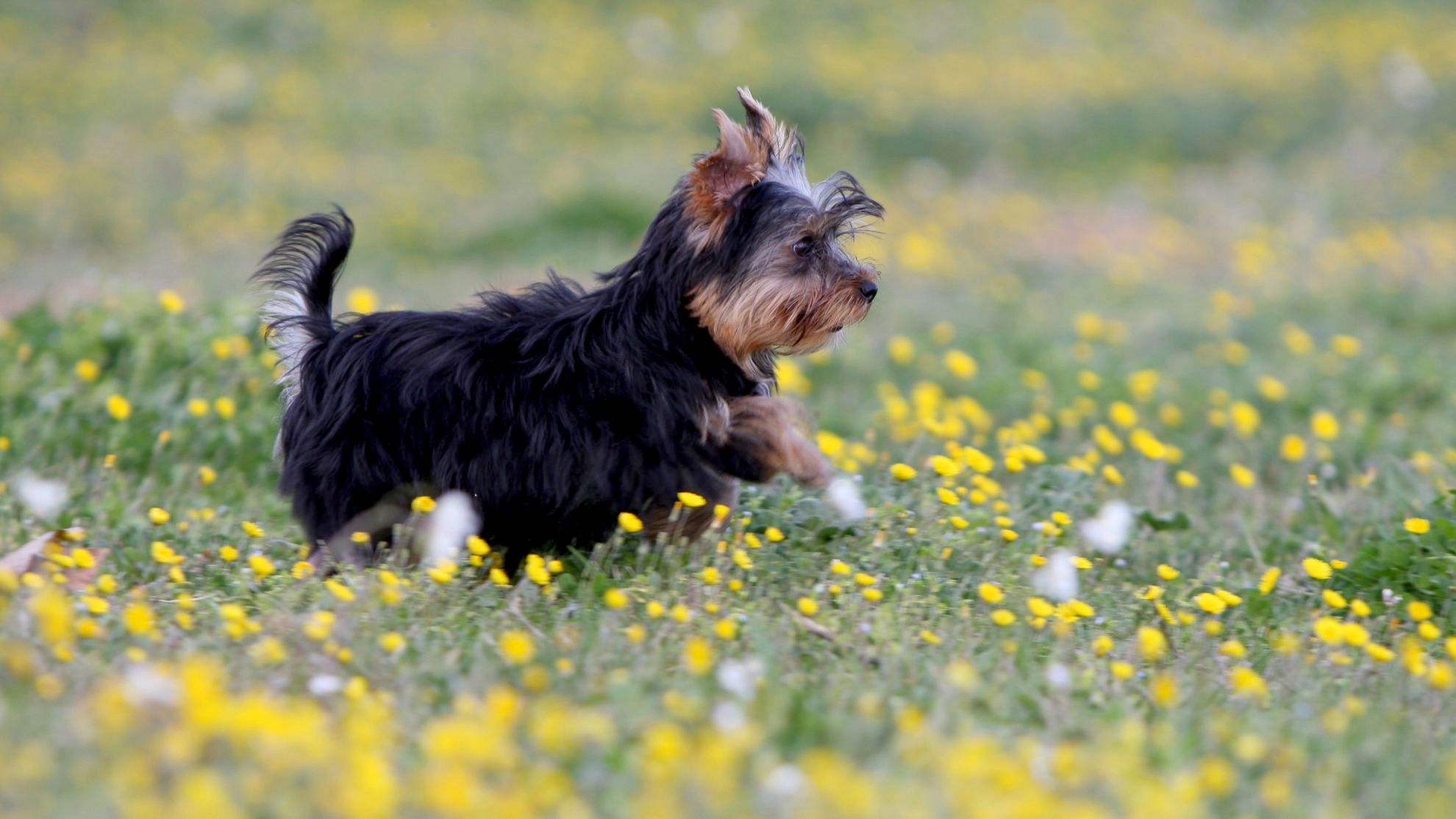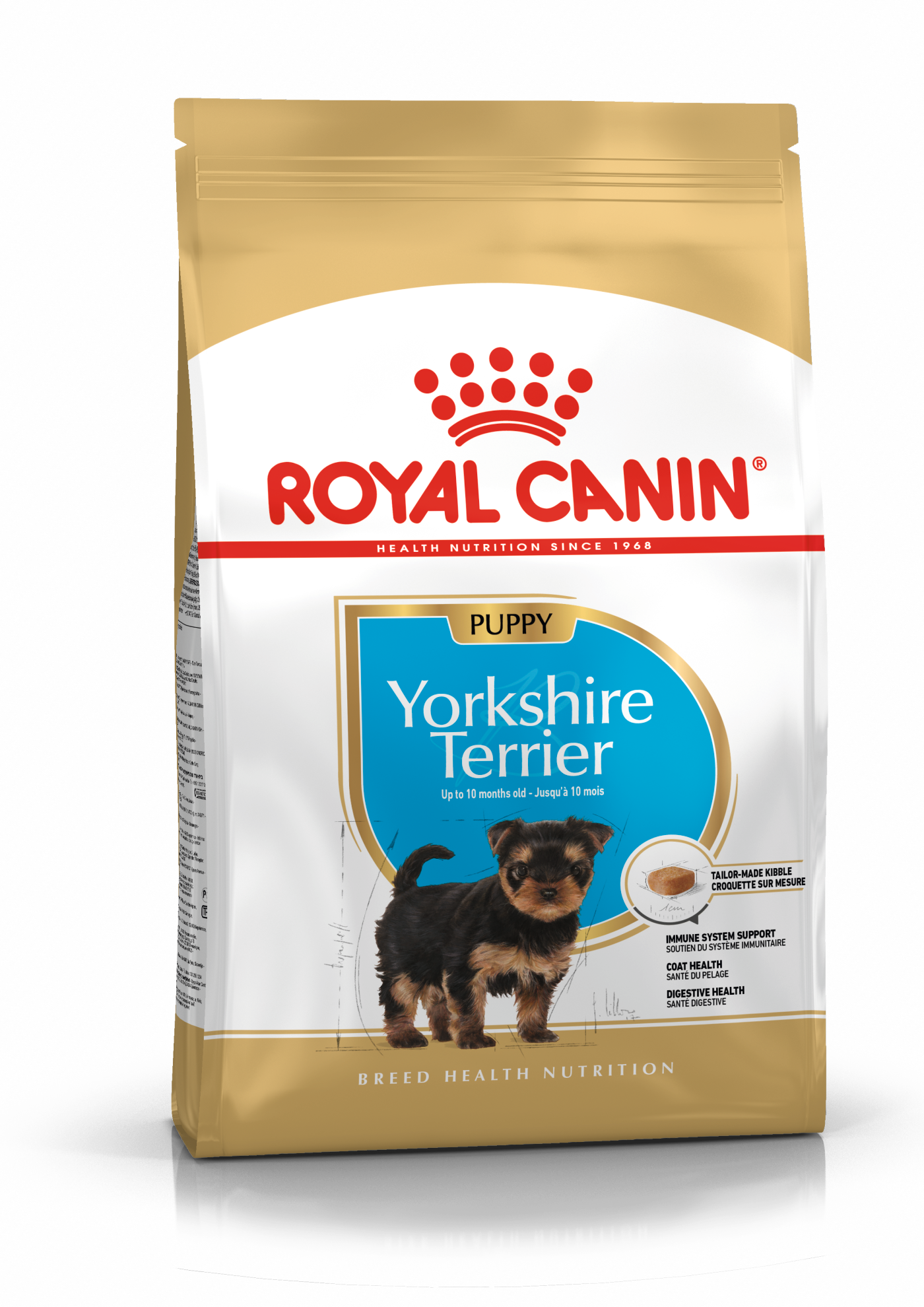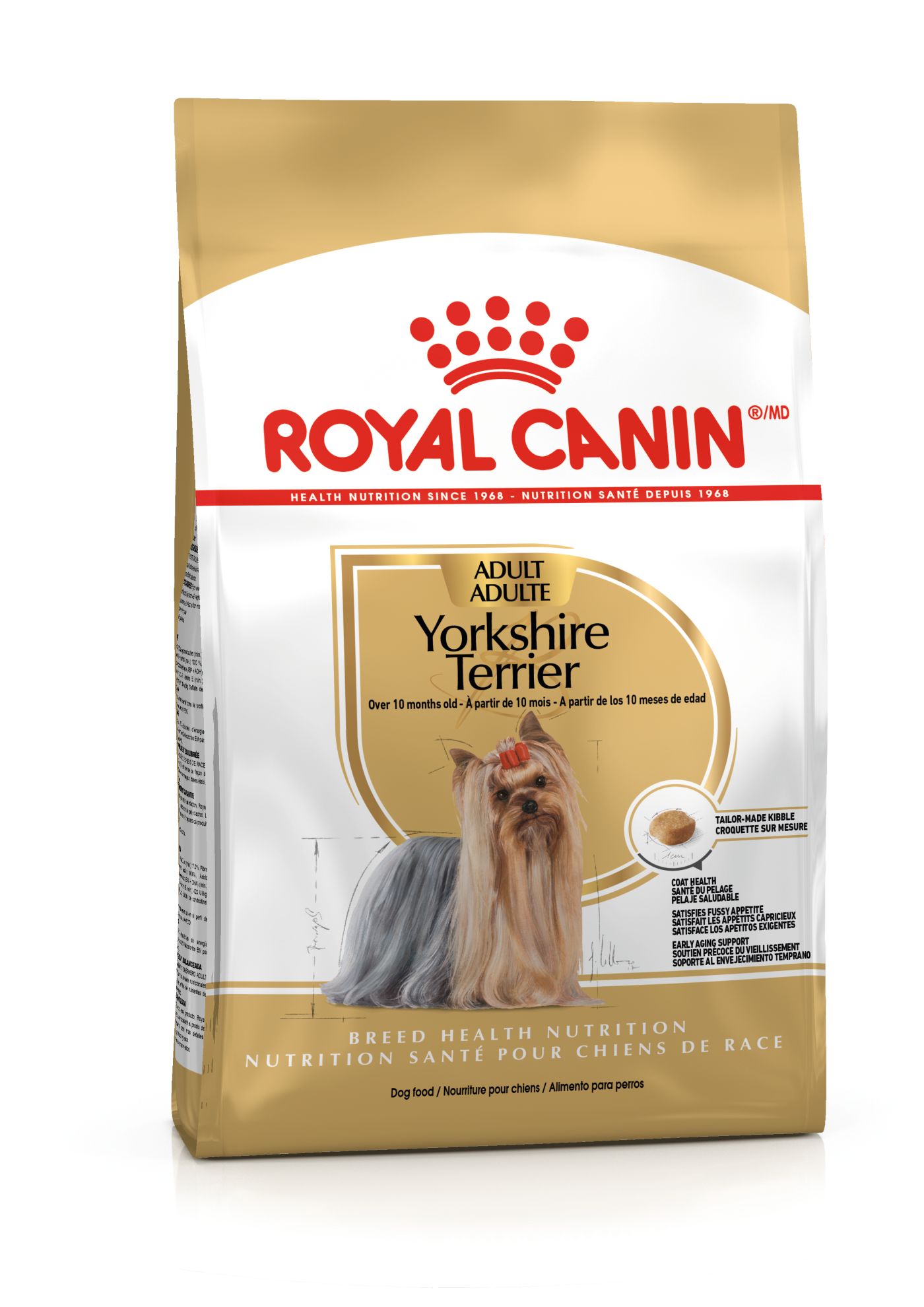Let's talk Yorkshire Terriers
Petite but plucky, what they lack in size these diminutive dogs more than make up for in character. Known for their feisty yet friendly temperament, Yorkshire Terriers have bags of personality, make great company and form close attachments to their human families. With all the traits of a true terrier, they make good little watchdogs too. Given all this, and their glorious mane of long silky hair, they are often rightfully described as a ‘miniature lion’.
Official name: Yorkshire Terrier
Other names: Yorkie
Origins: United Kingdom
Drooling tendencies
1 out of 5Grooming needs
4 out of 5Shedding Level
1 out of 5Barking tendencies
3 out of 5Energy level
1 out of 5Compatibility with other pets
3 out of 5Warm weather?
2 out of 5Cold weather?
1 out of 5Suited to apartment living
5 out of 5Can stay alone
2 out of 5Family pet
3 out of 5
| Male | Female |
|---|---|
| Height | Height |
| 18 - 20.5 cm | 18 - 20.5 cm |
| Weight | Weight |
| 1.8 - 3.2 kg | 1.8 - 3.2 kg |
| Life Stage | |
|---|---|
| Adult | |
| 10 months to 8 years | |
| Mature | Senior |
| 8 to 12 years | 12 to 22 years |
| Baby | |
| Birth to 2 months | |
Drooling tendencies
1 out of 5Grooming needs
4 out of 5Shedding Level
1 out of 5Barking tendencies
3 out of 5Energy level
1 out of 5Compatibility with other pets
3 out of 5Warm weather?
2 out of 5Cold weather?
1 out of 5Suited to apartment living
5 out of 5Can stay alone
2 out of 5Family pet
3 out of 5
| Male | Female |
|---|---|
| Height | Height |
| 18 - 20.5 cm | 18 - 20.5 cm |
| Weight | Weight |
| 1.8 - 3.2 kg | 1.8 - 3.2 kg |
| Life Stage | |
|---|---|
| Adult | |
| 10 months to 8 years | |
| Mature | Senior |
| 8 to 12 years | 12 to 22 years |
| Baby | |
| Birth to 2 months | |

Get to know the Yorkshire Terriers
All you need to know about the breed
Don’t be deceived by that dainty demeanour, mane of silky hair and cute bow. They may look like they’re always in the salon, but the Yorkshire Terrier is a hardy, resilient and clever little dog. Every bit the terrier, they are bold, fearless and tenacious, the latter being a left-over from their former hunting days.
Bred in the north of England during the Industrial Revolution (yes, despite that haughty stance, their roots really are working class), the job of the Yorkshire Terrier was originally to keep the mines and textile mills free of vermin. It wasn’t until late Victorian times that they became popular as a lapdog – and began, quite literally, living in the lap of luxury among the English upper classes.
Certainly, with their regal-like bearing, it’s as if the Yorkshire Terrier was always destined for greater things. But, in reality, they are a friendly, playful breed with an inquisitive nature that makes them lots of fun.
Among other Yorkshire Terrier characteristics, they are fond of attention and like to stay close to their owners. They can be quite protective of them if the need arises and, in some cases, have the potential to be a bit nippy. For this reason, as well as their small size, they are better suited to families with older children.
Famed, of course, for their show-stopping silky coats, they are often topped off with a hair accessory to keep their locks out of their eyes or with other various fashionable haircut styles. Interestingly, the Yorkshire Terrier’s long, silky coat is exceptionally fine and more like human or horse hair. It does require a bit of care to keep it as its glossy best, but, on the plus side, the Yorkie is a breed that doesn’t really shed, so no vacuuming the sofa required.
As one of the smallest breeds of dog, the Yorkshire Terrier’s compact size means they’ll also fit in well in most homes. Great companions for those living alone, the Yorkie is one of the longer-living breeds, too, and can easily reach their late teens. No wonder then that the Yorkshire Terrier is one of the most popular toy breed dogs world-wide.

Two facts about Yorkshire Terriers
1. A tale of two terriers
In L. Frank Baum’s illustrated book, The Wonderful Wizard of Oz, the little dog Toto appears to have been a Yorkshire Terrier. However, when the story was made into a film, the starring role was stolen by a Cairn Terrier. The Yorkies got their revenge, though, with an appearance in the Audrey Hepburn movie, Funny Face, which featured her own dog.
2. Bending your ear...
In other fun facts about the Yorkshire Terrier, did you know that the puppies are born with floppy ears? What is more, in some cases, they remain that way for life. This is only an issue if you intend to show your Yorkie, as the judges look for upright ears in the breed, but it is in no way a problem for the dog. Also, many people find it a rather endearing quality.
History of the breed
Hailing from the north-east of England, Yorkshire Terriers are named after the county from which they originate. No surprises there. What is perhaps a little more unexpected is that their story is closely linked to the Industrial Revolution.
During that time, in the 1800s, it was common for miners and mill workers to travel to the region seeking a job – and among them were a number of Scots. These would-be workers from the north brought with them their own breeds of terrier – and, in time, these Scottish dogs bred with the English varieties. This resulted in the Yorkshire Terrier breed that we know and love today.
Although we can’t be certain of their precise ancestry, it is thought the Yorkshire Terrier emerged from the crossing of at least three breeds of terrier – the old Black and Tab, the Maltese and the Skye. In any event, these tough little terriers went on to gain a reputation as an excellent hunting dog and were used to catch small vermin in the mines and mill buildings. The breed was officially recognized by the Kennel Club of England in 1886.
During the late Victorian era, the Yorkshire Terrier went on to become a popular companion animal – a lapdog favoured by the English upper classes. However, the breed’s popularity soon expanded far beyond Yorkshire and to the US. The Yorkie has been a firm favourite all over the world ever since.
From head to tail
Physical characteristics of Yorkshire Terrier
1.Head
2.Face
3.Body
4.Fur
5.Tail

Things to look out for
From specific breed traits to a general health overview, here are some interesting facts about your Yorkshire Terrier
The little legs of the Yorkie need extra-special care
One of the most common complaints in the Yorkshire Terrier is a dislocated kneecap (luxating patella). Once known as ‘trick knee’ in humans, it occurs when the kneecap literally pops out of place. Symptoms can include obvious discomfort, limping or an odd ‘skipping’ walk – and it can also lead to arthritis in later life. As always, prevention is better than cure, so it’s best to keep your Yorkie away from anywhere they might try and jump. If, however, the condition does occur, there is plenty that can be done, ranging from muscle-building exercises and weight management to anti-inflammatory medications. Surgery has a good success rate.
It’s better to use a harness rather than a leash
Like many small breeds of dog, Yorkshire Terriers can be prone to a condition known as tracheal collapse, which is a narrowing or collapsing of the windpipe. This can cause an obstruction of the airways resulting in symptoms ranging from a honking cough to noisy breathing and gagging sounds. In severe cases, it can also cause fainting. Caused by a genetic weakness, the condition is often triggered if a Yorkshire Terrier lunges forward when wearing a collar and leash, or if the owner pulls back too hard. Therefore, it is highly recommended to opt for a harness, which also helps with better control.
It’s important to look after their teeth and gums
Another thing to watch out for with Yorkshire Terriers is dental health. Because of their smaller, more crowded mouths, they can be more prone to problems such as gingivitis (inflammation of the gums) or periodontal disease (where the tooth’s entire support structure is affected).
In more serious cases, the resulting bacteria can spread around the body and damage the liver and kidneys, so it’s important to stay on top of this. The good news, though, is that daily brushing will help keep problems at bay. With teeth kept clean and healthy, the chance of infected gums is reduced in the first place. A good diet is vital, too, as are regular check-ups with a professional.
Healthy diet, healthier dog

When choosing food for a Yorkshire Terrier, there are many factors to consider: their age, lifestyle, activity level, physiological condition, and health, including potential sickness or sensitivities. Food provides energy to cover a dog’s vital functions, and a complete nutritional formula should contain an adjusted balance of nutrients to avoid any deficiency or excess in their diet, both of which could have adverse effects on the dog. The following recommendations are for healthy animals. If your dog has health problems, please consult your veterinarian who may recommend an exclusive veterinary diet. Clean and fresh water should be available at all times to support your Yorkshire Terrier’s urinary health. In hot weather and especially when out exercising, bring water along for your dog’s frequent water breaks.
Immune System Support
As puppies grow, they will experience big changes and new discoveries. During this key period, the puppy's immune system develops gradually. This formula helps support your puppy's natural defenses with an exclusive complex of antioxidants including vitamin E.
Coat Health
Enriched with omega-3 fatty acids (EPA and DHA), omega-6 fatty acids and biotin to support the health of the Yorkshire Terrier's beautiful long coat.
Digestive Health
Formulated with high-quality protein and prebiotics to support digestive health and a balanced intestinal flora, contributing to optimal stool quality.

The main nutritional goals for adult Yorkshire Terriers are:
Preserving the health and beauty of the skin and coat with the enriched provision of essential fatty acids (omega-3 - EPA-DHA - and omega-6), borage oil, and biotin.
Satisfying their fussy appetite. The size of the kibbles should be very small and adapted to the miniature jaw of Yorkshire Terriers in order to avoid problems with picking up food. Combined with great aromas and flavours, this will help stimulate their finicky appetite.
Maintaining an ideal body weight by using highly digestible ingredients and keeping the fat content at a sensible level.
Maintaining a healthy digestive system. A diet formulated with a balanced intake of fibres, to help facilitate intestinal transit, and with highly digestible proteins contributes to good stool quality.

After 8 years old, Yorkshire Terriers start facing the first signs of ageing. A diet enriched with antioxidants helps maintain vitality, and key nutrients, such as taurine, help support good cardiac function. Ageing is also accompanied by the modification of digestive capacities and particular nutritional requirements, so food for ageing Yorkshire Terriers should have the following characteristics:
Higher vitamin C and E content. These nutrients have antioxidant properties, helping to protect the body’s cells against the harmful effects of the oxidative stress linked to ageing.
Highly digestible proteins, a blend of prebiotics and fibres to help promote a balanced intestinal flora and optimal stool quality.
An adapted phosphorous content to help slow down the gradual deterioration of kidney function
A higher proportion of the trace elements iron, zinc, and manganese to help maintain good condition of the skin and coat
A higher quantity of polyunsaturated fatty acids (omega-3 and omega-6 fatty acids) to maintain the quality of the coat. Dogs can normally produce these fatty acids, but ageing can affect this physiological process.
As they age, dogs increasingly suffer from teeth problems. To ensure they continue to eat in sufficient quantities, the size, shape, and texture of their kibble needs to be tailored to their jaw. Kibble may be softened with warm water which can bring out the aroma and allow for easier eating. A formula that contains calcium chelators will support dental health by helping to reduce tartar formation.

Caring for your Yorkshire Terrier
Grooming, training, and exercise tips
Despite their coiffured good looks, Yorkies are still terriers through and through. So they do require a reasonable amount of physical activity every day. With their history as working dogs, they also benefit from being occupied rather than too sedentary. Boredom can lead to your Yorkshire Terrier barking more than is necessary. A daily walk is the minimum and ideally two if possible. They also enjoy playing games with their owners – especially if it involves a ball – as well as plenty of interaction (but that should be a given.)
Despite their long silky tresses, Yorkshire Terriers don’t tend to shed. However, their unique coat, closer to human hair, does require a gentle daily brushing to keep it looking its lustrous best. Extending almost to the ground if left to its own devices, it may also need an occasional trim. Regular baths are recommended – which is a chance to give their ears a check too – and nails should be clipped as needed. Other Yorkshire Terrier grooming tips include cutting their fringe to avoid it falling in their eyes. It can also be tied in that famous topknot with a bow. To keep things simple, some owners choose to have them clipped all over.
Though it’s true that they can be a bit stubborn at times, Yorkshire Terriers are generally eager to please. They are also fast learners and enjoy mental stimulation. This means they respond well to reward-based training. As this can also help cement the bond between dog and owner, it’s often an enjoyable process for both. Afterwards, Yorkshire Terriers can also excel at dog agility and obedience classes – and some go on to become excellent therapy dogs. Like other toy breeds, they can be a little slower to become house-trained, but they’ll get there with patience. In addition, early socialization with people and animals will reap dividends later.
Despite their coiffured good looks, Yorkies are still terriers through and through. So they do require a reasonable amount of physical activity every day. With their history as working dogs, they also benefit from being occupied rather than too sedentary. Boredom can lead to your Yorkshire Terrier barking more than is necessary. A daily walk is the minimum and ideally two if possible. They also enjoy playing games with their owners – especially if it involves a ball – as well as plenty of interaction (but that should be a given.)
Despite their long silky tresses, Yorkshire Terriers don’t tend to shed. However, their unique coat, closer to human hair, does require a gentle daily brushing to keep it looking its lustrous best. Extending almost to the ground if left to its own devices, it may also need an occasional trim. Regular baths are recommended – which is a chance to give their ears a check too – and nails should be clipped as needed. Other Yorkshire Terrier grooming tips include cutting their fringe to avoid it falling in their eyes. It can also be tied in that famous topknot with a bow. To keep things simple, some owners choose to have them clipped all over.
Though it’s true that they can be a bit stubborn at times, Yorkshire Terriers are generally eager to please. They are also fast learners and enjoy mental stimulation. This means they respond well to reward-based training. As this can also help cement the bond between dog and owner, it’s often an enjoyable process for both. Afterwards, Yorkshire Terriers can also excel at dog agility and obedience classes – and some go on to become excellent therapy dogs. Like other toy breeds, they can be a little slower to become house-trained, but they’ll get there with patience. In addition, early socialization with people and animals will reap dividends later.
7/7
All about Yorkshire Terriers
If you’re wondering how long Yorkshire Terriers live for, the average age is around 12 to 15 years. However, they can potentially live into their late teens. On average, female Yorkshire Terriers live an extra one-and-a-half years compared to males.
One question that is asked a lot is, do Yorkshire Terriers shed? While they are known for their long, flowing coats, they actually shed no more than normal human hair. On a related topic, you might be wondering if the Yorkshire Terrier is hypoallergenic. The answer is no, as there is, in fact, no such thing as a hypoallergenic dog. The main allergen is produced by all breeds regardless of their coat.
Tailored nutrition for your Yorkshire Terrier
Read more on this topic
Sources
- Veterinary Centres of America https://vcahospitals.com/
- Royal Canin Dog Encyclopaedia. Ed 2010 and 2020
- Banfield Pet Hospital https://www.banfield.com/
- Royal Canin BHN Product Book
- American Kennel Club https://www.akc.org/
Like & share this page